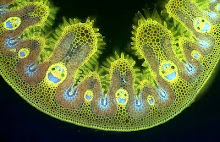Water hyacinth Eichhornia crassipes is often rated as one of the world's top ten worst weeds, thanks to its prodigious capacity to spread over the surface of lakes and rivers. It's said that just one plant can multiply to cover an acre of lake surface in eight months, thanks to its ability to produce stolons that sprout new plants from their tips. While vegetative spread explains its local abundance, its short-lived but beautiful flowers have also played a part in its current worldwide distribution in the tropics. It comes from South America but is now a problem in Africa, India and the Far East where it has been introduced as an ornamental species that has quickly rampaged out of control. It carpets parts of Lake Victoria in Africa, impeding navigation, and within a year of being introduced onto the Sudanese Nile in 1957 it had spread along 620 miles of river.
Water hyacinth isn't hardy in Britain, although there were a couple of reports of it surviving outside through the winter in Norfolk a few years ago. The last two severe winters would certainly have killed any plants in garden ponds, but it does make an attractive plant for a conservatory. Here it's sharing its indoor pond with another notorious aquatic weed, water lettuce Pistia stratiotes, which is equally prolific.
Water hyacinth owes its buoyancy to these inflated leaf petioles. When you cut these open ...
... you find that they are sub-divided into hundreds of small, rectangular compartments with thin walls of papery cells.
Although water hyacinth is a problematic weed there's a lot of research going in into useful applications of this plant. These include bioremediation - using its capacity to absorb and sequester toxic metals like mercury, chrome, lead, cadmium, zinc and arsenic via its fibrous root system that dangles in the water. Numerous trials have been carried out for waste water treatment. It has also been used as animal feed (from plants grown on clean water) and there's extensive research into using its rapid biomass production as a source of energy, by using the harvested plants to produce biogas or bioethanol.

















